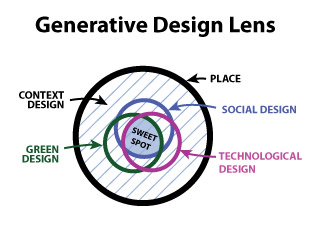 Generative Design starts with “place,” draws expertise from all design domains, and maximizes contribution to the well-being of all affected life.
Generative Design starts with “place,” draws expertise from all design domains, and maximizes contribution to the well-being of all affected life.
Throughout our planet’s over 4 billion-year history nature has been evolving itself to higher and higher levels of intricacy, beauty, interdependence, resilience and consciousness. This evolutionary process is our best demonstration of an “infinite game.”
If our social forms are to approach the same elegance and results we see throughout the rest of nature, we need to tap into the potential for synergy among all of our domains of design expertise. All the rest of nature enjoys full employment and collaborates to produce zero waste, and so can we.
Generative Design is a quest for wholeness, e.g., moving from social forms (organizations, communities, etc.) that are fragmented and/or fragmenting, toward forms that are alive, vital and conscious, capable of self-improving and self-evolving. Generative design involves designing for life any way you look at it.
Generative Design is a synergy-seeking quest drawing the most relevant expertise from all design domains in a way that —
Place: The geographically bounded space where humans intersect with the rest of nature.
Place could be a neighborhood, a community or a region. Ideally it would be a multi-community region consisting of relatively “whole” ecosystems — natural (e.g., watersheds) and socioeconomic. Every place has its unique essence — the “soul” of that place. Ideally “place” would be large enough to be politically significant but not limited by political boundaries, and it would be small enough to be thought of as one’s home.
Place is the alpha and omega of generative design. Here is where the “designers” can literally ground themselves — where they witness what is, imagine what has been, and envision what might be when its destiny if fulfilled — its potential fully realized.
When place is deeply appreciated and understood —
Design Domains
Context Design — Designing the game for a particular field of play: What could be the highest purpose of that which we are designing? How do we define success? How do we keep score? What do we choose to believe and value? What is our vision for our ideal future? What is our story for our journey, from where we are to who we can be? What language and metaphors best evoke the reality we want?
Technological Design — The design of our “things,” including built environment, i.e., our physical and electronic infrastructure. Breakthroughs in technological design brought us into the Industrial and then into the Information Age. We’re only beginning to see the potential of technology to contribute to the overall wellbeing of life.
Social Design — The design of purposeful relationships and agreements with self, each other, families, organizations, institutions, cities and nations. Social design includes the social practices, processes, systems and structures (roles, responsibilities, lines of accountability, etc.) that give form to those relationships and agreements.
Green Design — Crafting our relationships with, and agreements concerning, the rest of nature in a way that is not only sustainable, but truly cocreative. Green Design might be thought of as that subset of Context Design that brings the needs and gifts of nature into the foreground of our design thinking.